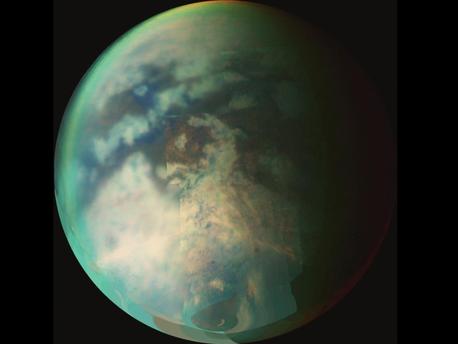Cassini Doubleheader
Flying By Titan and Dione
 © NASA/JPL/University of Arizona
|
Image from NASA's Cassini spacecraft of Saturn's moon Titan. This image is a composite of several images taken during two separate Titan flybys on Oct. 9 (T19) and Oct. 25 (T20). The large circular feature near the center of Titan's disk may be the remnant of a very old impact basin. The mountain ranges to the southeast of the circular feature, and the long dark, linear feature to the northwest of the old impact scar may have resulted from tectonic activity on Titan caused by the energy released when the impact occurred.
- » 1 - Titan´s haze-shrouded surface
- » 2 - Close encounter with Dione
Titan´s haze-shrouded surface
Cassini Doubleheader
Flying By Titan and Dione
 © NASA/JPL/University of Arizona
|
Image from NASA's Cassini spacecraft of Saturn's moon Titan. This image is a composite of several images taken during two separate Titan flybys on Oct. 9 (T19) and Oct. 25 (T20). The large circular feature near the center of Titan's disk may be the remnant of a very old impact basin. The mountain ranges to the southeast of the circular feature, and the long dark, linear feature to the northwest of the old impact scar may have resulted from tectonic activity on Titan caused by the energy released when the impact occurred.
- » 1 - Titan´s haze-shrouded surface
- » 2 - Close encounter with Dione






